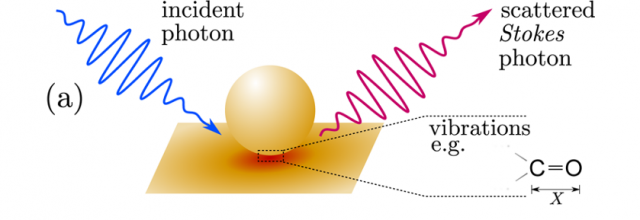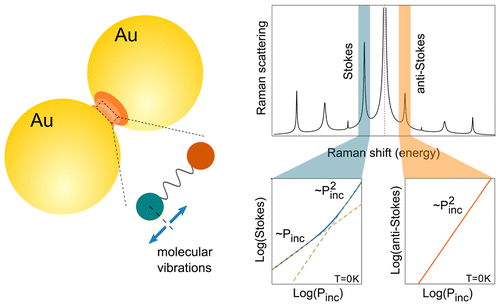Beyond the standard description of Raman scattering
When light encounters molecules, the predominant mode of scattering is elastic scattering (Rayleigh). This scattering is responsible for the blue colour of the sky, for example. It is also possible for the incident photons to interact with the molecules in such a way that energy is either gained or lost so that the scattered photons are shifted in frequency and in phase. Such inelastic scattering is called Raman scattering.
The intensity of Raman scattering is about one-thousandth of that of Rayleigh scattering in liquids; for this reason it was not discovered experimentally until 1928 by C.V. Raman and K.S. Krishnan in liquids, and the same year by L. Mandelstam and G. Landsberg in crystals, even though its existence was predicted by A. Smekal in 1923, and again in 1925 by H. Kramers and W. Heisenberg. However, it was not until the development of the laser that the effect was put to use.
In Raman espectroscopy light from a laser is passed through a substance. The resulting inelastically scattered photons can be of either lower (Stokes) or higher (anti-Stokes) frequency than the incoming photon. As the new frequencies in the Raman spectrum of monochromatic light scattered by the substance are characteristic of the substance, the technique is widely used as a way of determining molecular structure and is a common tool in chemical analysis.

Surface enhanced Raman scattering (SERS) is a spectroscopic technique in which the Raman scattering is increased by placing a single molecule in a hotspot of a plasmonic cavity, where the electric fields associated with the incident and the scattered photons are strongly enhanced. The difference between the energy of those two photons provides a fingerprint of the molecule, that is, detailed chemical information about its vibrational structure.
Since the initial observation of Raman scattering from single molecules, the use of a variety of plasmonic structures that act as effective optical nanoantennas over the last decades has allowed a tremendous advance of this molecular spectroscopy. Metallic particles such as nanoshells, nanorings, nanorods, nanowires, or nano stars, as well as plasmonic nanogap structures formed in particle dimers, nanoparticle-on-a-mirror morphologies, or nanoclusters are among the variety of structures that offer huge and controllable enhancements of the field intensity in their hotspots, boosting the inherently weak Raman scattering intensity, and ultimately enabling the chemical identification and imaging of particular vibrational modes of a molecule with subnanometer resolution.
These results suggest that some experiments might have reached the regime where the quantum-mechanical nature of both the molecular vibrations and the plasmonic cavity emerges and call for an adequate theoretical description that goes beyond the classical treatment of the electric fields produced in plasmonic cavities.

Now, a team of researchers from Materials Physics Center (CSIC-UPV/EHU), the Max-Planck-Institut für Quantenoptik, and DIPC has addressed 1 the underlying quantum-mechanical nature of Raman scattering processes by quantizing as bosonic excitations both the vibrations of the molecule and the electromagnetic field of a plasmonic cavity. In this description, the large enhancement of the Raman scattering from a molecule in the plasmonic cavity occurs thanks to the significant shrinking of the effective mode volume of a single photon.
The researchers complement this approach by employing an exact numerical solution of the quantum mechanical dynamics of the nonresonant Raman scattering process in a plasmonic cavity that fully describes the buildup of incoherent population of vibrations in the molecule, addressing the effect of phonon stimulated Stokes scattering, and furthermore, allows to account for the quantum and classical covariances between the two bosonic fields.
Their results point to phenomena which go beyond the standard description of Raman scattering such as (i) the onset of stimulated Stokes emission and (ii) the counterintuitive dependence of the anti-Stokes signal on the detuning of the incident laser from the cavity resulting from the pumping of the molecular vibrations.
This formalism thus predicts a variety of nonlinear quantum effects in the scattered signal that might have already been revealed in different Raman measurements, and opens the door for specific design of experimental configurations that can test, and eventually control, the underlying coherences within SERS. Furthermore, this model can be readily applied to a range of physical problems.
Author: César Tomé López is a science writer and the editor of Mapping Ignorance
References
- Mikolaj K. Schmidt, Ruben Esteban, Alejandro González-Tudela, Geza Giedke, and Javier Aizpurua (2016) Quantum Mechanical Description of Raman Scattering from Molecules in Plasmonic Cavities ACS Nano doi: 10.1021/acsnano.6b02484 ↩